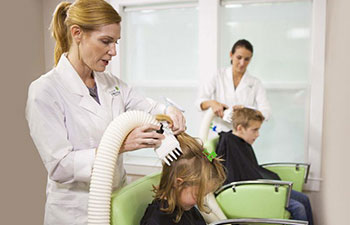As anyone who has come into contact with lice can attest, it’s a truly unique experience. Though tiny in size, they can bring households to their knees and have inspired countless tales and so-called remedies. But what to do when they come calling? With school soon in session and the end of camp, we turned to LCA Miami Clinic Owner Heather Wilson O’Connor to get the facts on these tiny creatures.
Is there any actual way to prevent Lice?
There are several preventative measures that can be used to reduce the chances of being infested. Most important of all is diligence. We recommend checking all family members once per week as early detection can make all the difference. Girls should wear their hair in a tight braid or bun when they are in social settings and we recommend not sharing items like hats, brushes, and hair accessories. Additionally, there are products available such as shampoos, conditioners and sprays which contain preventive ingredients. Just be sure to read the ingredients, as all natural, non-toxic options are the best choice. And surprisingly, lice prefer clean hair so washing one’s hair less frequently can actually be a preventive step! Ultimately, it’s about awareness and teaching your kids to be aware as well.
How are lice transferred?
Lice don’t fly and they don’t jump. They actually crawl very quickly along strands of hair and can move head to head with great ease given the right opportunity. Close interactive play, a hug, or a quick whisper in the ear of a friend are all examples of how lice can easily take up new residence with an unsuspecting host. Interestingly, we are seeing a significant rise in head lice with older kids due to taking “selfies” with their smartphones! As mentioned earlier, sharing things like hats, brushes, hair accessories, pillows, etc. can also be to blame.
What are the symptoms to look for?
The most telltale sign is an itchy head although a small percentage of people never feel the itch. Hot spot areas for itchiness are at the neck, around the ears and on the crown of the head. Also, the eggs (nits) tend to look like dandruff in the hair and are often mistaken as such. If those white flecks in the hair don’t move and seem glued to the hair shaft then most likely they are lice eggs. They will also tend to be very close to the scalp.
If your child has Lice what are the best steps to get rid of them?
Lice can be incredibly stressful and confusing. If there’s any doubt, get a professional to assess the situation. Once an infestation is diagnosed by a professional or from self-examination, there are a few options. The OTC products have been around for years, however, we now have “Super Lice” that have become resistant to these products. Additionally, they have never been able to kill the eggs and they are also laden with chemicals and toxins. If someone is interested in treating at home, it is doable with time, patience and perseverance. Make sure to use a professional grade nit comb and commit to a regimen of strand by strand combing for several days until all eggs and lice are removed. This takes time as the tiny eggs are the biggest challenge to remove. Another option is the FDA cleared AirAlle treatment. This is exclusively offered by Lice Clinics of
America and uses controlled heated air to kill lice and 99.2 percent of eggs in a single treatment. It is a three-step treatment process that requires approximately 90 minutes depending on level of infestation, texture and length of hair.
Lice can be really stressful, how do you know when you’re truly done with the treatments and the Lice are not coming back?
Being eagle-eyed and incredibly diligent will let you know if lice remains or not. When in doubt, professional consultation will also give peace of mind. By following the guidelines I mentioned earlier you can greatly reduce this from happening again in the future but let’s face it, lice have been around for centuries and will probably stick around to cause undue stress for a few more! Education and prevention is key; if we can end the stigma that comes with lice, we will see less recurrence of it. People who talk openly about their lice experiences with friends and family will lead them to be diligent and proactive themselves which will greatly reduce the chance of a re-infestation.





 Deering Estate
Deering Estate
 Massage Envy South Miami
Massage Envy South Miami
 Calla Blow Dry
Calla Blow Dry
 My Derma Clinic
My Derma Clinic
 Sushi Maki
Sushi Maki
 Sports Grill
Sports Grill
 The Healthy Kitchen
The Healthy Kitchen
 Golden Rule Seafood
Golden Rule Seafood
 Malanga Cuban Café
Malanga Cuban Café

 Kathleen Ballard
Kathleen Ballard
 Panter, Panter & Sampedro
Panter, Panter & Sampedro
 Vintage Liquors
Vintage Liquors
 The Dog from Ipanema
The Dog from Ipanema
 Rubinstein Family Chiropractic
Rubinstein Family Chiropractic
 Your Pet’s Best
Your Pet’s Best
 Indigo Republic
Indigo Republic




 ATR Luxury Homes
ATR Luxury Homes


 2112 Design Studio
2112 Design Studio
 Hamilton Fox & Company
Hamilton Fox & Company
 Creative Design Services
Creative Design Services
 Best Pest Professionals
Best Pest Professionals
 HD Tree Services
HD Tree Services
 Trinity Air Conditioning Company
Trinity Air Conditioning Company
 Cisca Construction & Development
Cisca Construction & Development
 Mosquito Joe
Mosquito Joe
 Cutler Bay Solar Solutions
Cutler Bay Solar Solutions


 Miami Royal Ballet & Dance
Miami Royal Ballet & Dance
 Christopher Columbus
Christopher Columbus
 Pineview Preschools
Pineview Preschools
 Westminster
Westminster
 Carrollton
Carrollton
 Lil’ Jungle
Lil’ Jungle
 Frost Science Museum
Frost Science Museum
 Palmer Trinity School
Palmer Trinity School
 South Florida Music
South Florida Music
 Pinecrest Orthodontics
Pinecrest Orthodontics
 Dr. Bob Pediatric Dentist
Dr. Bob Pediatric Dentist
 d.pediatrics
d.pediatrics
 South Miami Women’s Health
South Miami Women’s Health

 The Spot Barbershop
The Spot Barbershop
 My Derma Clinic
My Derma Clinic




 Miami Dance Project
Miami Dance Project

 Rubinstein Family Chiropractic
Rubinstein Family Chiropractic
 Indigo Republic
Indigo Republic

 Safes Universe
Safes Universe
 Vintage Liquors
Vintage Liquors
 Evenings Delight
Evenings Delight





 Atchana’s Homegrown Thai
Atchana’s Homegrown Thai
 Baptist Health South Florida
Baptist Health South Florida

 Laser Eye Center of Miami
Laser Eye Center of Miami
 Visiting Angels
Visiting Angels
 OpusCare of South Florida
OpusCare of South Florida

 Your Pet’s Best
Your Pet’s Best





 HD Tree Services
HD Tree Services
 Hamilton Fox & Company
Hamilton Fox & Company


 Creative Design Services
Creative Design Services